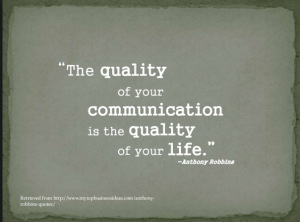

By Julie Oshins, “Play It Forward”
Every client has an idea or vision of what his or her ideal celebration looks like. Many can articulate this vision but most cannot, at least not fully. Through consistent and positive communication, successful DJs ask questions and create a dialogue, which helps the vision take shape. Trust is earned. Confidence is built. Communication is the essence of what we do that creates revenue for our livelihood. It is THE KEY to sales, customer service, dealing with hiccups, and the foundation of relationships built to last. It is integral to our business, and yet, according to George Bernard Shaw,
“ The single biggest problem in communication is the illusion that it has taken place”.
So many of us lack mastery of this problem because we are ignorant of the complexity of our own communication. So much of language is unspoken, comprised of looks and gestures and sounds that are not words. 7-10% of communication is words, 35% tone, and 55% non-verbal. Hearing is often confused with actually listening.
We’ve all had that experience of talking to someone and we feel like their attention is elsewhere, and they are not really listening to us. It’s incredibly disempowering, and leaves the speaker feeling like they haven’t been heard and what they have to say is not important. Not how we want our clients to feel, is it?
Effective communication requires active listening. When you listen to someone completely, attentively, you are not only paying attention to the words, you are aware of the physical gestures, the feeling of what is being conveyed, not just to the part of it but the whole of it.
Want more productive communication in all your relationships? Improve your active listening skills. Here are some suggestions that will help:
1. Make Eye Contact:
Eyes are the windows to the soul. Making eye contact conveys you are present and listening. It encourages the speaker and makes you seem more trustworthy as well.
2. Ask Questions:
This lets the speaker know you, as the listener, are engaged. Questions facilitate understanding while providing information and ways you can fulfill the client’s wants and needs.
3. Avoid distracting gestures or actions:
When you play with your papers, for example, you give the impression you are not listening. This behavior pulls your energy away and breaks the connection.
4. Recreate:
Paraphrase what the speaker is saying, say what they said in a different way to reassure them you are listening and to make sure that you’ve understood them correctly.
6. Avoid interrupting the speaker:
Allow them to complete their thought before responding and try to avoid anticipating what you think they will say. This is my personal pet peeve!
7. Know when to be quiet:
Silence allows the speaker to become aware of their own feelings and proceed at his/her own pace. Uncomfortable with the silence, listeners often feel the need to talk or ask a question which tends to disrupt and derail the speaker. Listen to the speaker’s non-verbal cues and consider how you might respond. This can empower you to give the most helpful response. Remember, we have two ears and only one mouth for a reason!
Effective communication throughout the process builds trust, reassures your client, and helps to relieve some of the stress that comes with planning for the biggest day of their lives. This includes prompt replies to calls, emails and/or texts. How would you feel having to repeatedly reach out to someone before they respond?
Amanda Peterson said it best, “The way you communicate reveals everything about you. Words are the clothes your thoughts wear.”
